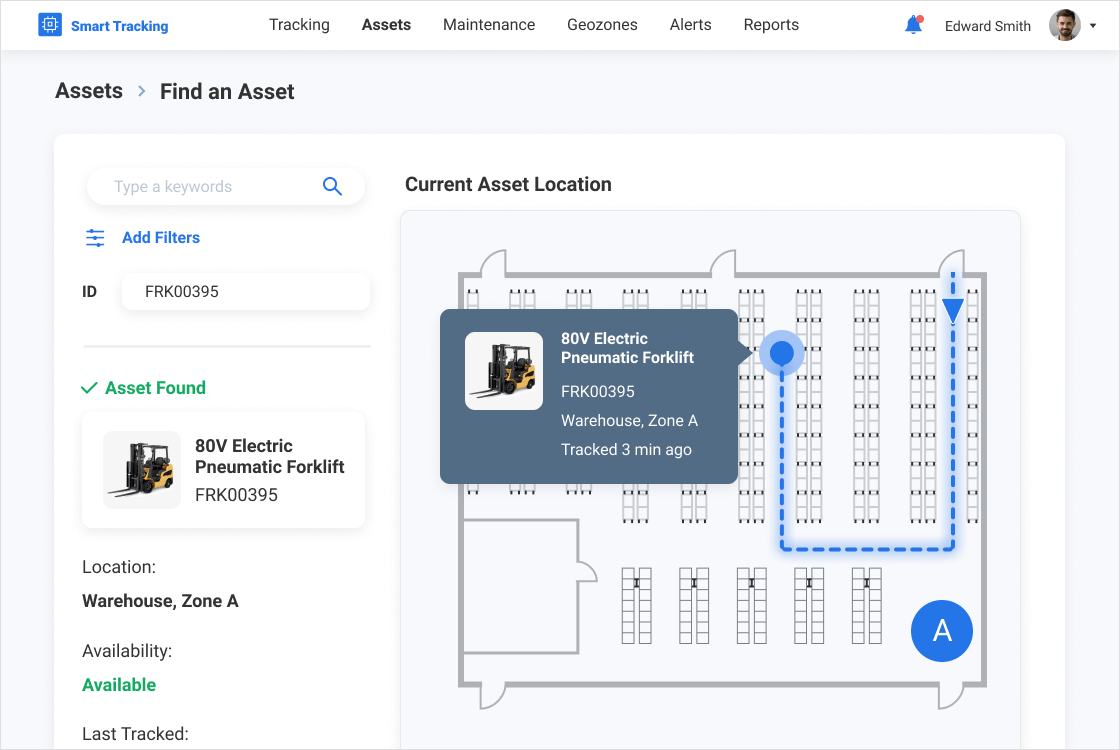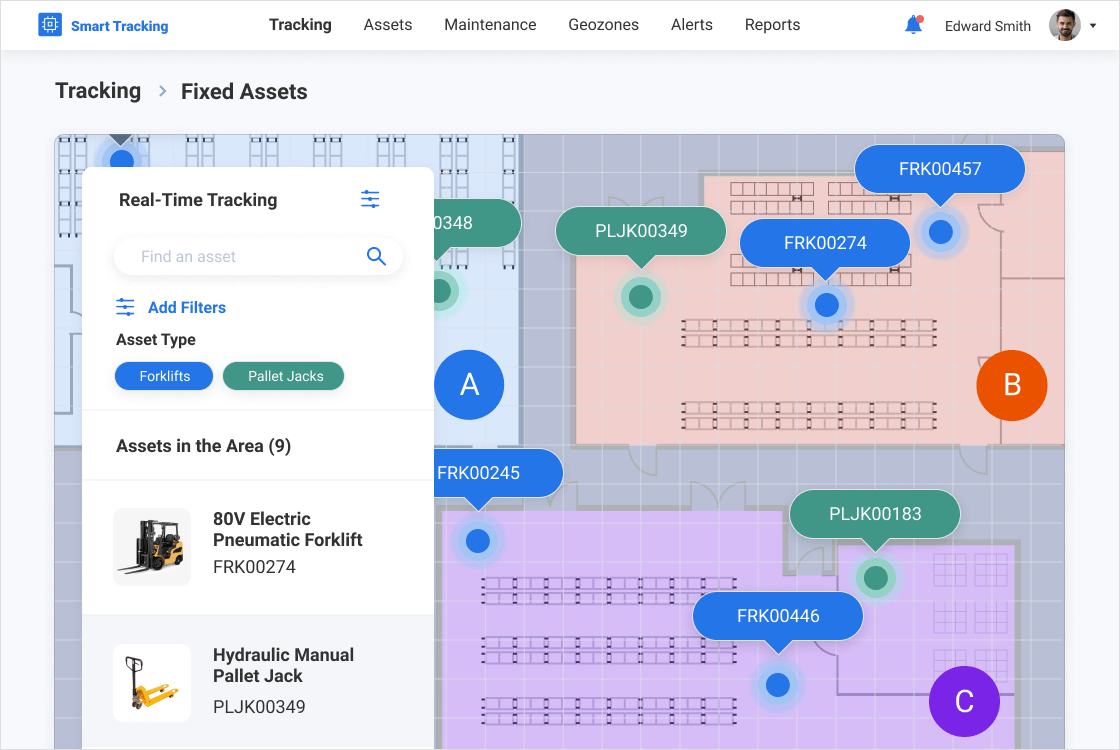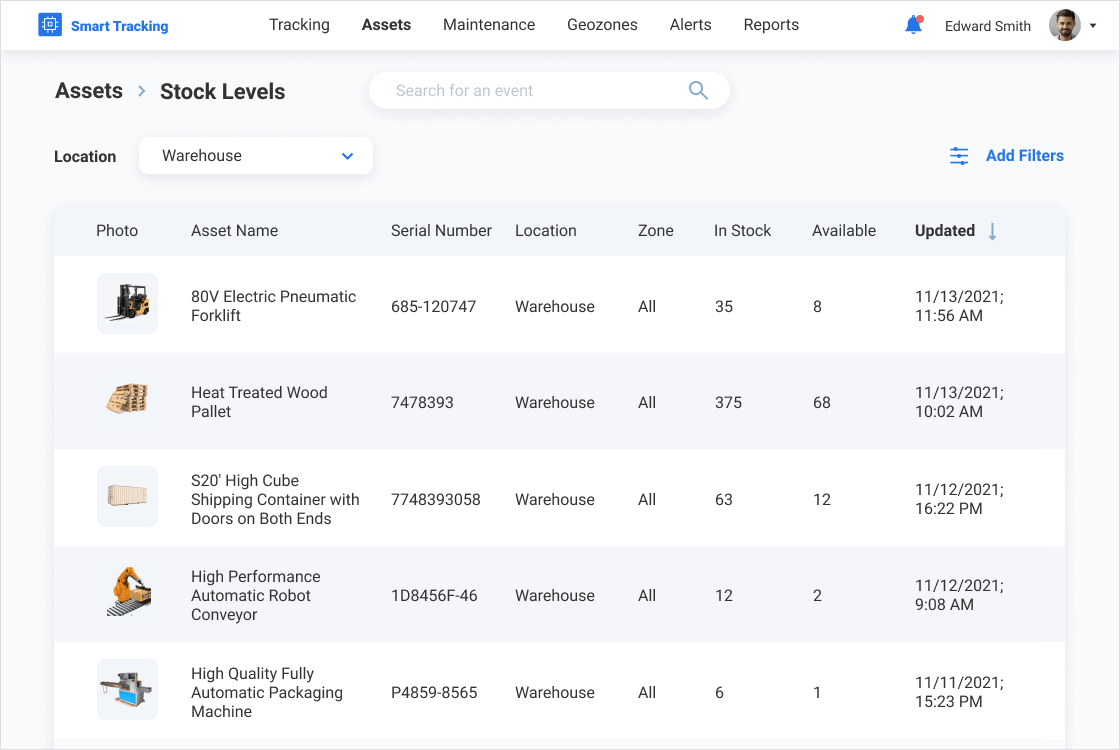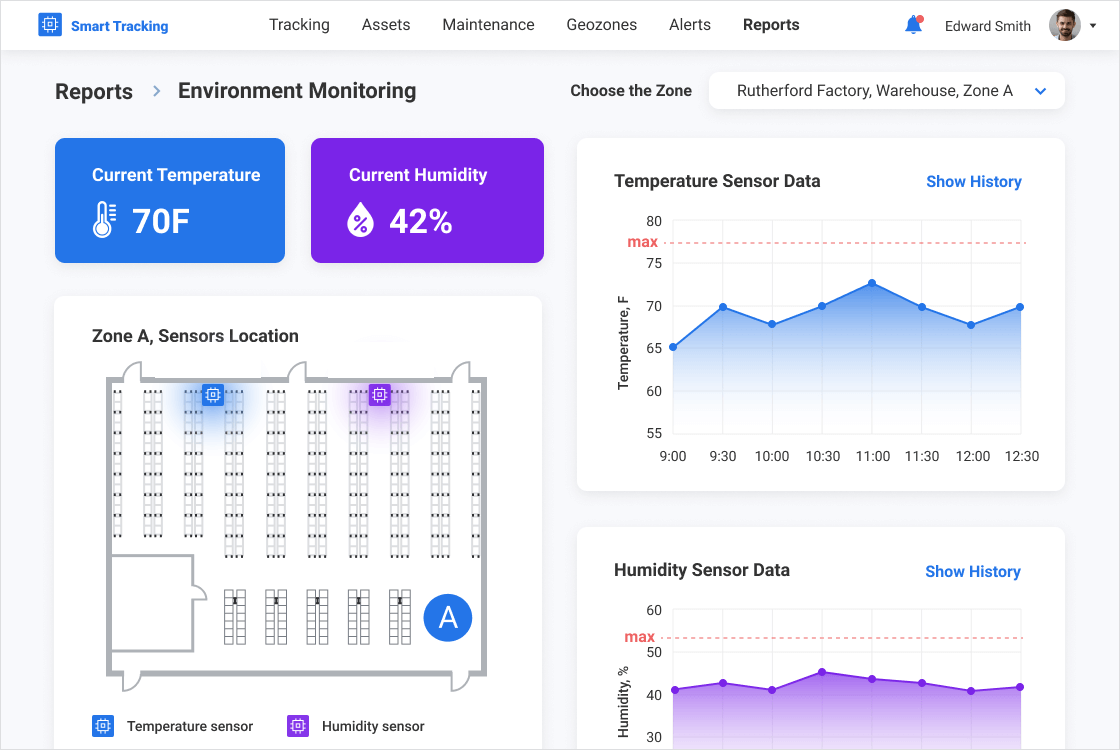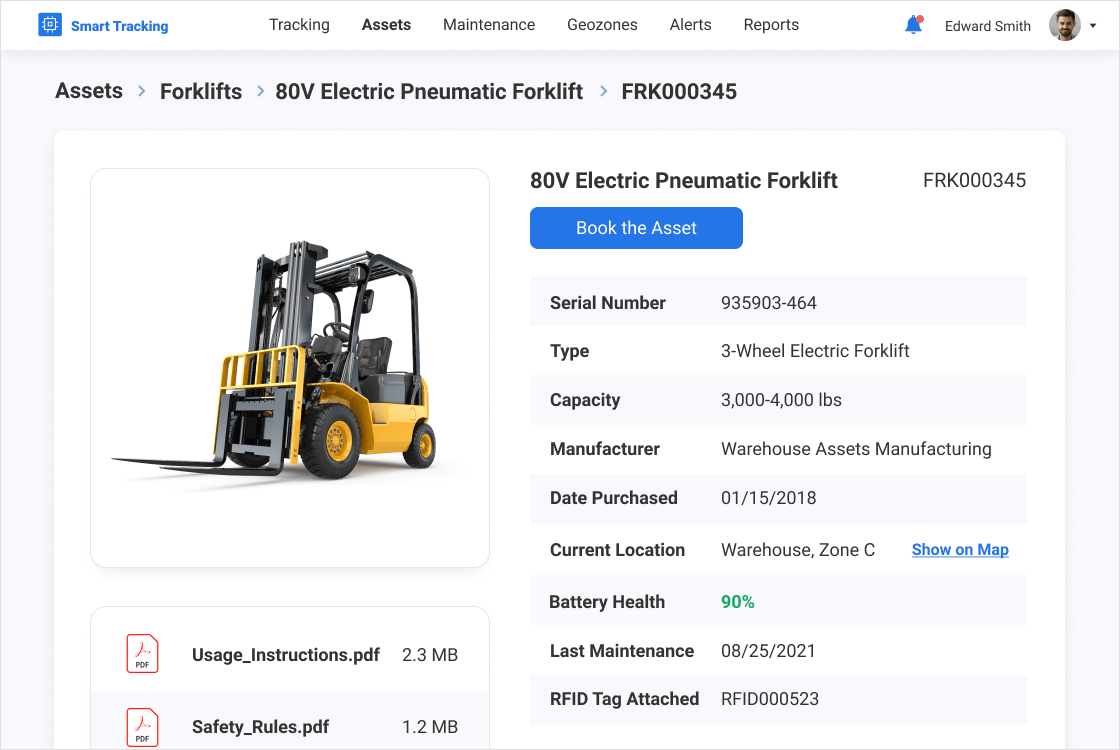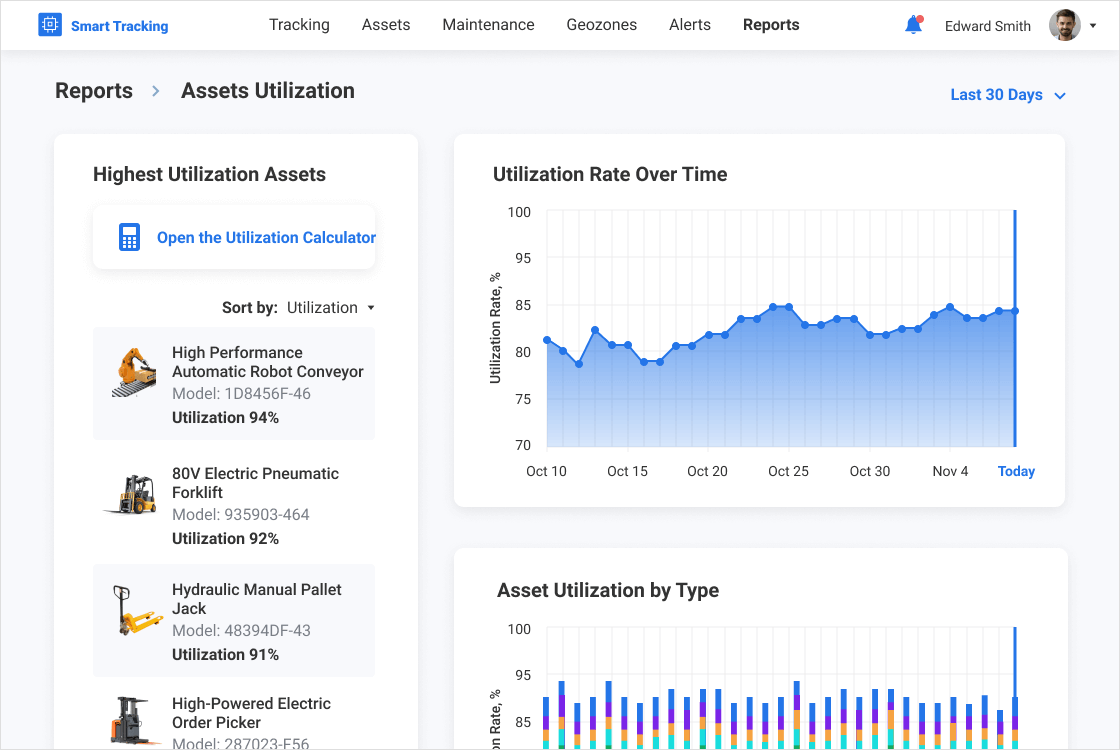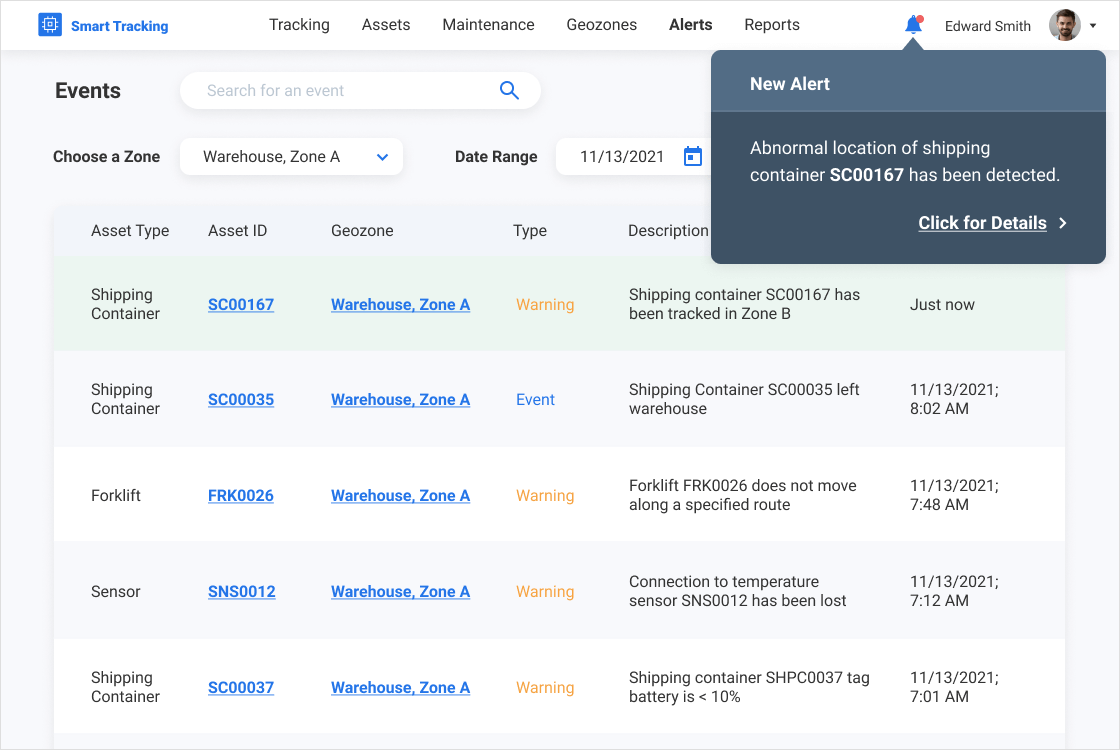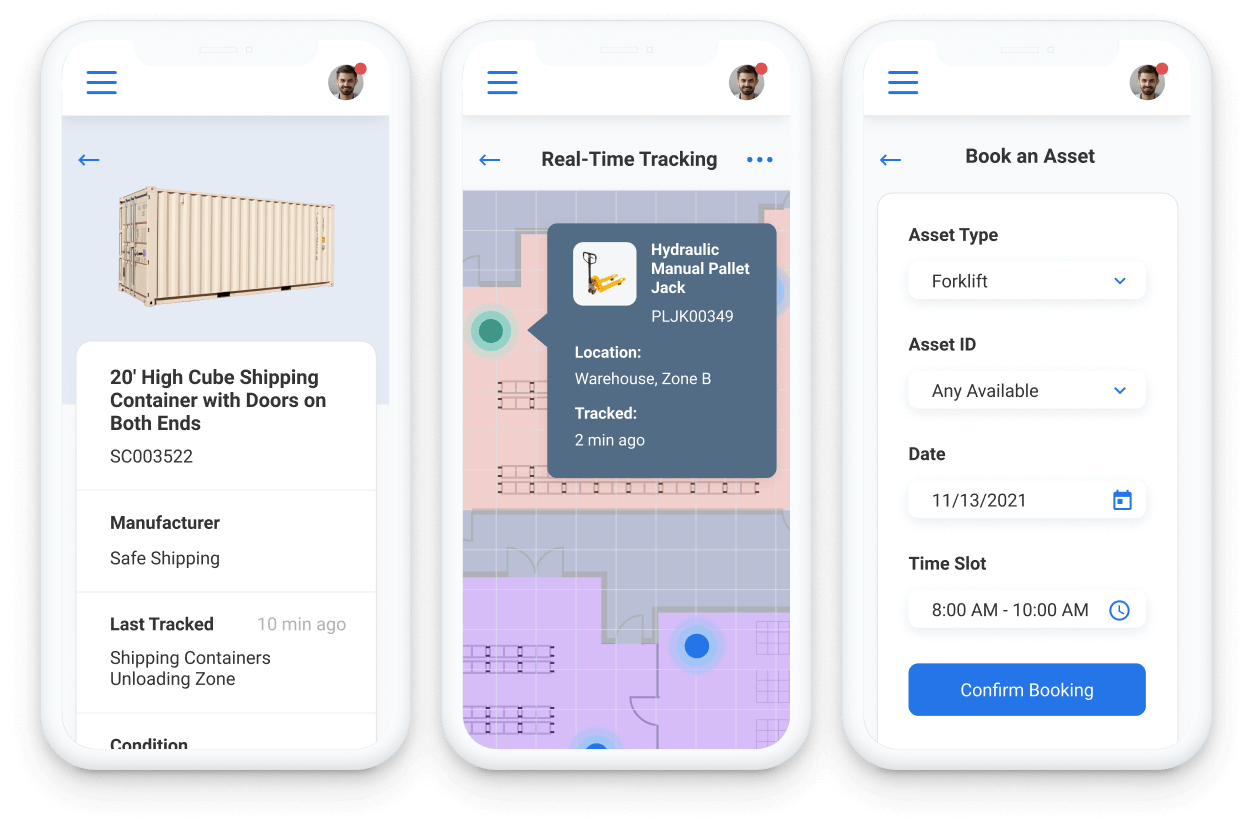Real-Time Asset Tracking
Features, Integrations, Costs, and Benefits
In software development since 1989, ScienceSoft provides full-cycle digital asset management consulting and development services to help companies create reliable real-time asset tracking solutions.
Real-Time Asset Tracking: the Essence
Real-time asset tracking allows asset-intensive companies (e.g., from manufacturing, transportation, healthcare, oil & gas, etc.) to instantly locate physical assets both indoors and outdoors, monitor their condition and usage, and optimize asset allocation.
Real-time asset tracking systems integrate with ERP, MES, enterprise asset management, etc. to help companies achieve full asset flow transparency, maximize asset utilization, and increase ROA.
The cost of real-time asset tracking software depends on asset types, tracking technology, integrations, and functionality. For midsize companies, prices typically range from $150,000 to $300,000+. Use our cost calculator to get a free ballpark estimate for your case.
Asset Tracking Market Highlights
The global market of asset tracking solutions was valued at $17.75 billion in 2021 and is expected to grow at a CAGR of 13.91% during 2022–2027. The main drivers for the popularity of asset tracking software across various industries are increasing demand for streamlined asset control, full visibility of asset location, prevented asset theft and misuse, timely asset maintenance.
Did you know that:
- 52% of enterprises rely mainly on reactive asset maintenance.
- 43% of small businesses use manual methods of asset tracking or do not track assets at all.
- 54% of organizations still capture and store asset data in a paper format.
- Employees involved in asset control and maintenance operations spend 75% of their working time on low-value tasks.
- 76% of companies operating in the manufacturing industry prioritize preventive maintenance.
- By 2030, over 90% of enterprise and industrial asset tracking solutions are expected to be augmented with IoT.
Real-Time Asset Tracking System Architecture
Based on ScienceSoft’s experience in end-to-end development of asset tracking solutions, we share a sample architecture of a real-time asset tracking system with short explanations of its core layers.
![]()
Platform layer includes:
- Data aggregation – asset data sourcing, quality management, transformation, etc.
- Asset data storage – both structured (geolocation, stock information, etc.) and unstructured (text files, images, etc.) asset data.
- Data analytics and visualization – aggregated asset data is presented to users in the form of reports and real-time dashboards (asset location and condition, asset utilization rates, asset maintenance history, etc.).
Gateway layer – routing asset data from the physical to the platform layer.
Physical layer – assets with barcodes or tags (RFID tags, GPS chips, Bluetooth Low Energy (BLE) tags, Ultra-Wideband (UWB) tags, etc.) and readers (barcode scanners, RFID readers, smartphones, etc.) to track them.
The choice of the tracking technology is based on asset mobility, required location accuracy, and tracking frequency. For example, real-time location systems (RTLS) based on UWB are commonly used for locating assets indoors with a high level of precision, while GPS systems are widely used for outdoor tracking.
Real-Time Asset Tracking Software Functionality
ScienceSoft creates asset tracking software with unique functionality tailored to each company's business specifics. Here, we have outlined the features commonly requested by our clients:
Asset data storage and navigation
- Storing 360-degree asset data (asset serial number/barcode and type, pictures, manufacturer, model, date of purchase, location, etc.) in an asset profile.
- Asset data storage in hierarchical asset structures.
- Accessing asset data via PC, tablet, smartphone.
- Searching asset data by asset serial number/barcode, photo, name, type, location.
- Role-based asset data access for all authorized parties: maintenance teams, asset reserving specialists, asset optimization managers, etc.
Real-time asset tracking
- Tracking enterprise assets (by type, serial number/barcode, proximity, availability):
- Fixed assets (plant machinery, tools, equipment, etc.).
- Linear assets (pipelines, power lines, drainage systems, etc.).
- Fleet assets (cars, trucks, shipping containers, etc.).
- Asset location and movement tracking (both indoors and outdoors) using interactive maps and geofencing.
- Tracking asset warranty dates and maintenance schedules.
Real-time asset condition monitoring
- Sensor-based monitoring of the condition (temperature, vibration, etc.) of assets in use, storage, or transfer.
- Sensor-based environment monitoring (temperature, humidity, air pressure) of operating, transported, and stored assets.
- Monitoring of asset-relevant inventory stock levels (spare parts, pipelines, service equipment, etc.).
- Asset utilization monitoring.
- Configurable notifications on scheduled asset maintenance and calibration dates, low asset stock levels, and more.
Asset tracking analytics and reporting
- Real-time analysis of asset utilization data for:
- Spotting asset misuse and under-/overuse.
- Optimizing asset scheduling and reservation.
- Asset performance data analysis to accurately plan asset maintenance, repair, calibration, replacement, etc.
- Asset state and environment data analysis to optimize asset operating, storage, and transportation conditions.
- Scheduled and ad hoc asset reports: asset procurement, asset location, asset utilization over time, asset depreciation, high-demand assets, and more.
Should You Invest in Custom Asset Tracking Software?
Answer a few simple questions and find out whether you should opt for a custom system or a market-available tool.
Do you need your software to support specific asset types (medical devices, drilling rigs, TBMs, livestock, etc.) or complex workflows like multi-location asset tracking?
Do you need software with specific features, e.g., computer-vision-based asset tracking, asset visualization using digital twins, or AIoT-enabled prescriptive maintenance?
Do you need to integrate your software with multiple corporate solutions, legacy tools, or specific tracking hardware?
Do you work with regulated assets (e.g., in healthcare, defense, or public sector) and need your solution to meet strict compliance and security requirements?
Do you need customizable asset tracking software with various interfaces for different roles in the asset management team?
Do you plan to evolve your solution with new functional and non-functional capabilities in order to adjust it to changing business requirements?
Do you have large teams involved in asset management processes and look to avoid the software fees associated with the per-user subscription model?
Please tell us a bit more about your needs
Answer at least 3 questions to get results.
You can go with off-the-shelf asset tracking software
Looks like market-available tools are a viable option to meet your needs. Turn to ScienceSoft if you need help with choosing the optimal ready-made software, its implementation, customization, or integration with your existing systems.
You definitely should consider custom development
A tailored asset tracking solution will help you reap the unique benefits that market-available tools cannot offer. Turn to ScienceSoft to get a detailed assessment of a custom asset tracking system’s feasibility for your needs.
Custom asset tracking software is your best choice
Looks like market-available tools don’t fit your specific needs and won’t be able to provide the expected operational and economic feasibility. Turn to ScienceSoft to get a consultation on custom development and receive cost and ROI estimates.
Real-Time Asset Tracking Systems: Important Integrations
ScienceSoft recommends integrating the asset tracking solution with relevant corporate software to eliminate double data entry across disparate systems and ensure consistency of asset utilization and performance data. Essential integrations include:
![]()
Enterprise resource planning (ERP) system
By loading 360-degree asset data from real-time asset tracking software into ERP, a company ensures its Operations and Finance departments achieve full visibility into current asset utilization and performance, asset repairing and replacement needs, asset procurement needs, etc.
Enterprise asset management (EAM) system
Instant transfer of the current information on the asset performance and utilization from the asset tracking solution to the EAM system to help define optimal asset usage and maintenance scenarios, plan asset replacement and purchasing, optimize the asset management strategy.
Automated loading of data on asset procurement and utilization from tracking software into accounting software for timely and accurate asset depreciation.
Computerized maintenance management system (CMMS)
By accessing real-time data on asset location, condition and maintenance needs, companies can promptly and accurately schedule service activities.
How to Ensure the Success of a Real-Time Asset Tracking System
In asset tracking software projects, ScienceSoft always seeks to cover the following important factors that may bring the customer additional value across the asset tracking processes:
Real-time reporting and alerting capabilities
Asset managers, maintenance teams, production managers, and other employees can get a convenient view of real-time asset data and receive notifications about potential negative events like asset misplacement, disruption, inadequate asset conditions, spare part stockouts, etc.
Focus on system security
Tracking assets in real time, especially in regulated industries like healthcare (e.g., hospital asset tracking), requires that asset data is safely stored and transmitted. For that, asset data encryption, multi-factor user authentication, and other security mechanisms should be employed.
Flexible integration capabilities
Well-documented APIs allow for seamless integration with multiple types of software (EAM, ERP, MES, etc.).
User-friendly interfaces
To enable employees to quickly and conveniently operate real-time asset data and easily reveal valuable asset insights.
How to Estimate Asset Tracking Software Implementation
The cost of implementing real-time asset tracking software varies greatly depending on the number and type of assets tracked (which influences the choice of the tracking technology), the scope of integrations, solution's capabilities, and more.

From ScienceSoft's experience, developing real-time asset tracking software for a midsize company may cost around $150,000–$300,000+. Although precise cost estimation is only possible after a thorough business analysis, we can provide a free ballpark estimate for your custom software.
Want to learn the cost of your asset management solution?
Benefits of a Real-Time Tracking System for Assets
Financial outcomes
|
|
Maximized ROA due to increased asset availability and utilization, reduced asset loss and theft. |
|
|
Reduced asset maintenance costs and eliminated unplanned downtime due to the timely detection of abnormal asset functionality and possible asset failure. |
|
|
Cost savings connected with the asset tracking automation (elimination of wrong data entries, timely location of critical assets, etc.). |
|
|
Eliminated tax overpaying due to accurate tracking of asset depreciation. |
Operational outcomes
Off-the-Shelf Asset Tracking Software to Consider
Below, ScienceSoft lists the leading software products recognized by Gartner and IDC. Each product offers robust functionality for real-time asset tracking. Although vendors of these products don’t provide hardware (tags, sensors, etc.) as a part of their offering, they map compatible hardware and hardware vendors they partner with.
Dynamics 365 Asset Management
ScienceSoft recommends
Software category
ERP software
Description
Asset Management is an advanced module in Dynamics 365 Supply Chain Management for tracking and managing assets in real time. The product has been positioned in the Major Players category in the IDC MarketScape for SaaS and cloud-enabled asset-intensive EAM applications for 2020-2021.
- Locating various types of assets (machines, production equipment, and vehicles) in real time.
- Monitoring asset condition, alerting based on pre-defined rules.
- Keeping track of maintenance activities and their costs.
- Tracking asset maintenance status.
- Storing asset data in hierarchical structures.
- Pre-defined reports on asset location, number, uptime, downtime, repairs, mean time between failures/stops, etc.
- User-friendly interface.
- A mobile version is available.
- Cloud and on-premises deployment.
Pricing
Dynamics 365 Supply Chain Management – $180/user/month (for up to 100 assets per tenant).
IBM Maximo
Software category
EAM software
Description
A recognized leader of the Gartner Magic Quadrant for enterprise asset management and asset performance management solutions.
- Asset location and condition tracking with barcoding/RFID/sensors.
- AI-powered detection of asset anomalies/malfunctions, alerting based on pre-defined rules.
- 150 pre-built reports (asset availability and reliability, asset uptime, asset history, asset failure analysis, asset cost analysis and vendor analysis, etc.).
- Custom reporting and dashboarding capabilities.
- A mobile version is available.
- Cloud, on-premises and hybrid deployment.
- Integration with the SAP/Oracle ERP systems via the ERP adapter.
Pricing
Pricing depends on the number of users and the deployment option. Prices are available by direct request to IBM.
SAP Enterprise Asset Management (EAM)
Software category
EAM software
Description
A leader of the IDC MarkerScape Worldwide SaaS and Cloud-Enabled Asset-Intensive EAM Applications Vendor Assessment.
- Real-time asset location and asset utilization tracking with interactive visualization, location maps, etc.
- Centralized asset data storage with 360-degree asset data.
- Asset condition monitoring, asset alerting based on pre-defined rules.
- Built-in BI module for pre-built/custom report generation (asset location, asset status, asset work orders, etc.).
- A mobile version is available.
- Cloud-based deployment.
- Integration with SAP S/4HANA for seamless asset data exchange across the company.
Pricing
Prices are available by direct request to SAP.
UpKeep
Software category
CMMS
Description
UpKeep CMMS is a modern cloud-hosted maintenance and asset management solution for small to midsize companies across various industries.
- GPS- and RFID-based real-time asset location.
- Asset condition monitoring, asset alerting based on pre-defined rules.
- Tracking asset depreciation and asset repair costs.
- Pre-built (asset downtime, asset usage, asset costs, work order history, work orders costs, etc.) and custom reports.
- Intuitive user interface.
- A mobile version is available.
Pricing
- Community – free
- Starter - $35/user/month
- Professional - $60/user/month
- Business Plus - $100/user/month.
Implementation of Real-Time Asset Tracking with ScienceSoft
In software development since 1989, ScienceSoft helps companies launch effective real-time asset tracking solutions to streamline their asset tracking process and increase ROA.
Real-time asset tracking software consulting
- Asset tracking needs analysis.
- Assessment of the existing asset tracking infrastructure (if any).
- (optional) Proof of concept development.
- Asset tracking hardware consulting.
- (for platform-based solutions) Choosing a fitting platform and defining the customization scope.
- (for custom solutions) Designing the optimal software features, architecture, and tech stack.
- Implementation planning: a project plan, time and cost estimates, a risk mitigation plan, etc.
Real-time asset tracking software implementation
- Conceptualizing the real-time asset tracking solution.
- (for custom solutions) Real-time asset tracking software architecture design.
- Software development or customization.
- Solution integration with hardware and corporate systems: ERP, EAM, EHS, etc.
- Quality assurance of real-time asset tracking software.
- (optional) User training in a preferred format.
- After-launch support and evolution.
About ScienceSoft
ScienceSoft is a global IT consulting and software development company headquartered in McKinney, Texas. We deliver real-time asset tracking solutions to help our clients establish transparent asset utilization flows, maximize the asset useful life, and reduce operational costs. An ISO 9001- and ISO 27001-certified company, we rely on a mature quality management system and guarantee that cooperation with us does not pose any risks to our clients’ data security. ScienceSoft's top priority is driving EAM project success despite time and budget constraints and changing requirements.


